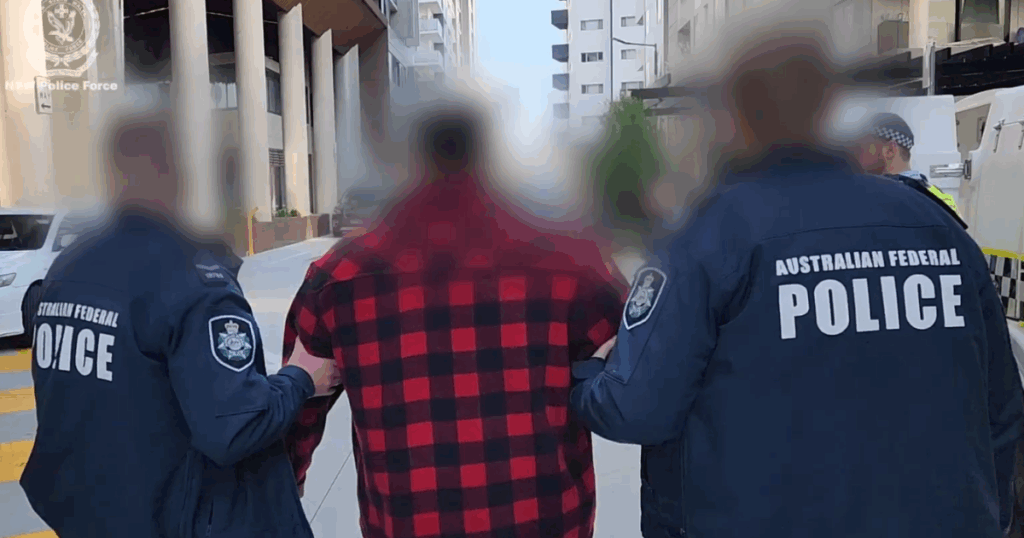
In a shocking incident that has gripped the Queanbeyan community, members of an alleged outlaw motorcycle gang (OMCG) reportedly locked women and children inside a local shop during a violent double stabbing on August 8, 2025. The details emerged as two of the seven accused applied for bail, revealing a chilling narrative of organized crime and intimidation.
The court proceedings disclosed that eight men, allegedly affiliated with the bikie gang, orchestrated the attack by driving in a convoy to the Crawford Street business, parking nearby. While some remained in the vehicles and others served as lookouts, a group entered the premises armed with weapons.
Allegations of a Calculated Attack
Once inside, the gang reportedly encountered women and children in the shop’s foyer. In a move that underscores the brazen nature of the attack, one gang member allegedly locked the door, preventing these bystanders from escaping as the violence unfolded. The two male victims, aged 26 and 29, were then assaulted and stabbed in a storeroom, sustaining serious injuries.
Among the defendants, 25-year-old Dean Geiger from Queanbeyan is accused of restraining one of the victims, facilitating the attack on the other. Geiger is also alleged to have held the man when he himself was stabbed.
Bail Applications and Legal Arguments
Seven alleged gang members were apprehended this week, charged with wounding with intent to murder. Five of the accused did not seek bail and were remanded in custody by the NSW Local Court on September 4. However, two defendants, 33-year-old Benjamin James Moarefi from Gordon in the ACT, and Geiger, did apply for bail.
The prosecutor, opposing bail, claimed Moarefi was present during the incident and inside the storeroom at the time of the stabbing. Although a firearm was reportedly brandished, police have yet to recover it. Moarefi’s lawyer, Peter Woodhouse from CODA Criminal Law, argued that his client’s involvement was minimal, emphasizing identification issues among the defendants and a lack of evidence suggesting witness interference.
“If it was going to happen, you might think it would already have happened,” Woodhouse stated, challenging the prosecution’s concerns.
During Geiger’s bail hearing, the prosecutor described the event as a “clearly organized criminal enterprise” with Geiger’s active participation. His lawyer, Rosemary Benet, highlighted his strong community ties and lack of a criminal record, suggesting a local church minister was willing to provide him accommodation if released.
Judicial Decisions and Community Reactions
Acting Magistrate Wills, recognizing the gravity of the allegations, denied bail for both Moarefi and Geiger, citing the risks involved. The five defendants who did not apply for bail include Mason Geoffrey Harrison Novakovski, Jack McFarlane, Jason Pahl, Nicholas John Lawrence, and Jacob Turner. Arrests occurred in both Canberra and Queanbeyan, with all cases adjourned to October 28 at the Queanbeyan Local Court.
Earlier, Detective Chief Inspector Keith Price from NSW Police confirmed that both stabbing victims have been discharged from the hospital and are recovering. The incident has sparked widespread concern, highlighting the audacity of organized crime groups and their disregard for public safety.
Implications and Future Considerations
This case underscores the ongoing challenges law enforcement faces in curbing the influence of outlaw motorcycle gangs in Australia. The alleged actions of locking in bystanders during such a violent act have raised questions about the safety of community spaces and the lengths to which these groups will go to enforce their dominance.
As the legal proceedings continue, the community remains on edge, hoping for justice and increased security measures to prevent similar incidents. The upcoming court date will be closely watched, as it may set a precedent for how such cases are handled in the future.
The Queanbeyan incident is a stark reminder of the persistent threat posed by organized crime, prompting calls for more stringent measures and community vigilance. As the legal system grapples with the complexities of this case, the broader implications for public safety and law enforcement strategies remain a critical focus.






